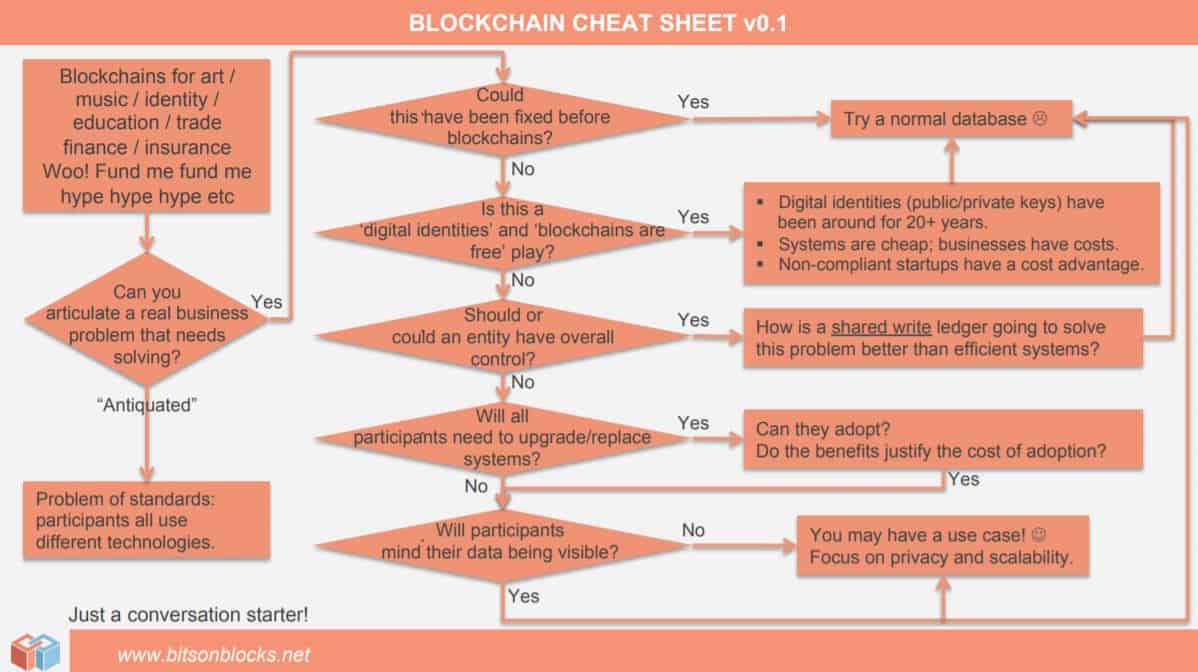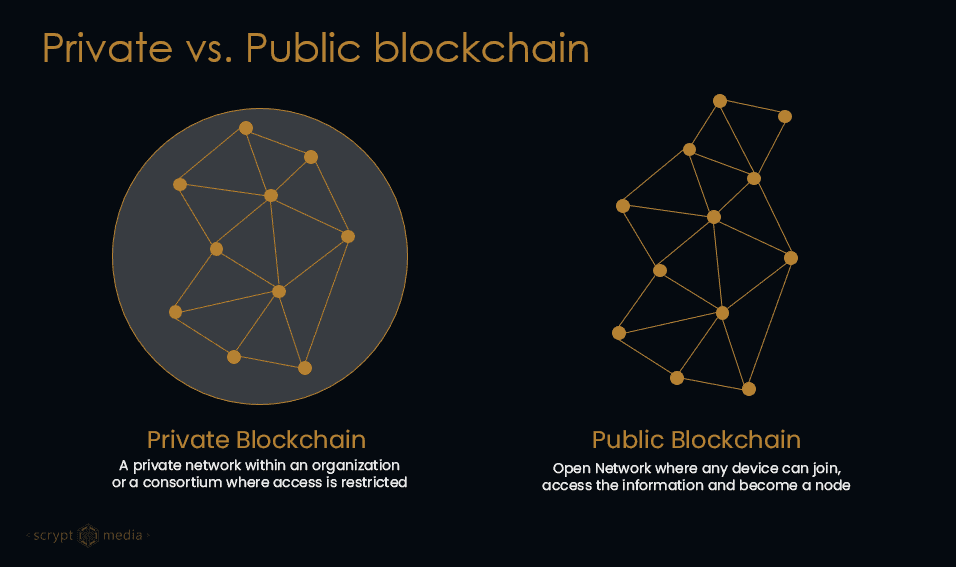Blockchain technology is one of the most hyped and generalized topics of latterly. Nevertheless companies that understand its mechanisms, know their business needs, and are able to match these two, can expect true value from blockchain adoption.
Introducing any technology is not merely a technical decision, but most of all a business decision. Especially innovative technologies present a real challenge for CXOs. The struggle to have a clear view of the blockchain landscape when faced with making an informed decision requires a thought-through process of evaluating a potential implementation.
Why blockchain has gained so much attention
Blockchain is, above all, intended to enable individuals to exchange assets in a trustless way. It eliminates the need to rely on a third party to manage the transactions. Therefore, it’s key value for businesses is primarily in cost reduction. Other advantages are: decentralization, cryptographic security, transparency, and immutability. These facilitate faster and more secure services delivery. Additionally, the network logic facilitates and foster unbiased cooperation that benefits all parties involved.
Many experts see Blockchain as a major 21st century transformative technology, much like the Internet was in the 90s. There are plenty of use cases being developed rapidly where businesses are leveraging the distributed ledger, take a look at some of them in “Blockchain business applications beyond bitcoin” article, that also explains the blockchain concept and takes it further than money exchange platform.
Like with every innovative technology in its early stage of adoption, there are still challenges that need to be addressed. The risks are mainly: underdeveloped regulatory landscape, requirement of vast amounts of computing power and potential privacy & security issues. On one hand, if you wait until the blockchain technology matures, you might be losing the opportunity of gaining a competitive advantage. On the other hand, you should make a fully informed decision about blockchains implementation and determine if and how your company and its users can benefit from blockchain solutions.
What to consider when thinking of blockchain implementation
Each introduction of new technology requires well-considered framework of adoption Thinking of blockchain adoption you should consider two major aspects: perceived usefulness and perceived ease of use by the intended user.
Step 1. Decide if blockchain’s adoption can significantly impact your business
When deciding on if you really need a blockchain-based solution can become more clear after asking these questions:
- Is transparency and traceability an important part for me?
- Is decentralization vital to my solution?
- Can I achieve a time-reduction in end-to-end processes after the implementation of a blockchain-based solution?
- Am I looking to access new sources of finance?
- What types and amounts of data do I want to store on a distributed ledger?
- Who the network participants will be?
- How much control do I want to have over the stored data?
There are quite a few decision-tree models that enable the rapid initial analysis of whether blockchain is an appropriate solution for a defined problem. This Medium post presents 7 blockchain decision models with their pros and cons. I personally like the Lewis cheatsheet best, because of its simplicity, but I’m encouraging you to check all of them.

Source: https://bitsonblocks.files.wordpress.com/2016/01/2016-01-26-fintech-finals-hk.pdf
Facing blockchain adoption? Read insights from 8 Blockchain experts: “Blockchain Adoption Kit: 101 for business”.
Step 2. Look for practical use-cases for inspiration
Thanks to the open architecture of blockchain there are plenty of use cases being developed that you can take away from. Some of the most promising are:
- Asset tokenization seems to be one of the most exciting blockchain applications. The ability to represent the ownership of real world assets on a blockchain can disrupt the way we manage them. Maecenas , is an online marketplace that want to give art lovers the chance to buy shares in famous paintings.
- Companies that have complex supply process with multiple contract manufacturers and suppliers can benefit from distributed ledger technology. Supply chain offers us plenty of use cases, e.g. Provenance, the project that aims to bring more transparency into the fashion industry. It’s goal is to track every aspect of a garment’s life through all the development phases.
- Some projects are designed specifically for use with IoT (Internet of Things). IOTA aims to enable secure trading and sales transactions, while removing the biggest barriers from the world of digital assets, primarily slow transaction speeds, lack of scalability, and mining expenses.
- Ultimate transparency can be reached because all changes to the blockchain are transparent and public. By 2030 we can expect personal data and government records being stored on Blockchain-based identity. Such initiative aims to reduce the risk of security breaches, allows autonomy and self-sovereignty across borders.
- Blockchain applications in electricity sector allow users to go beyond centralised grid of energy supply. In the Power Ledger project, the smart metering of electricity generated through an individual’s solar panels can be recorded, traded and settled on a ledger.
What are blockchain use cases that caught your attention? Tell us in the comments.
Step 3. Develop a PoC
Your Proof of Concept (POC) has to demonstrate the feasibility and practical potential of your project. It can either be a prototype without any supporting code, or any MVP (Minimum Viable Product) with bare featureset. How can it look in practice?
A few months ago, the team of my colleagues and software developers, took part in the Hack Yeah – the biggest stationary hackathon in Europe! Their category was blockchain development. The project was about loyalty programmes that are complex and consist of many users and transactions, so the immutable and secure blockchain nature can make a system bulletproof to human failure and cyberattacks. The developed project was a loyalty system based on blockchain technology. We had to guarantee data security (including access rights) and system’s scalability and readiness for business use, so we decided to use the Hyperledger platform – a global collaboration, hosted by The Linux Foundation. The code ensured consistency of data written on blockchain – no one can spend more points than they have. The application focused on a blockchain-backend part, assuming that after the implementation, the user interface would probably be replaced with the current interface of the loyalty platform consistent with the visual identification of the company that ordered the project.
You can read all the programming details and how the PoC was developed in the blog post: “Simple Blockchain Network with Hyperledger Composer”.
Step 4. Decide on your blockchain type
The three main types of distributed ledger technology are:
- Permissionless, public blockchain
- Private, permissioned blockchain
- Hybrid blockchain

The difference between public and private blockchain is related to participants and their allowance to utilise the network. A public blockchain network is completely open and anyone can join and participate. A private blockchain on the other hand, requires an invitation, therefore places restrictions on the participants in the network.
The difference in who is allowed to participate matters because it affects how decentralization is achieved.
- Public blockchains are secured by Cryptoeconomics and cryptocurrency mining. The downside of such blockchain is that it is not ready to handle huge amounts of transactions and data that businesses usually process.
- A permissioned or private blockchain is a blockchain where the consensus process is controlled by a pre-selected set of actors and is more suitable for business applications.
If you need true decentralization and it’s difficult to gain trust from the users of your product , take a look at the public blockchain. A private one, in the other hand, would be more suitable if you want a secure database and your business needs to be “on the blockchain”. If you need a little bit of both — then permissioned might be the way to go.
Step 5. Think of the end-user
Gartner predicts rapid evolution of the blockchain market. The experts do not expect there to be a single dominant blockchain platform within the next five years. Instead, they expect a multiplatform world to emerge. Developing a blockchain solution isn’t different from building any other technical solution. You need to have the end-user in mind from the very beginning. Achieving the user ease of use can be more difficult here, due to the immaturity of the market adoption Blockchain has its own set of UX (user experience) challenges. You need to adopt a different mindset, learn new terms and understand the new solutions. User education will be the way to go, but it takes time and patience.
Wrap up
Fast-pacing changes in blockchain technology are both tempting and confusing. How can CXOs have a clear view of the blockchain landscape? If you’re looking for consultancy and blockchain development services, we can help you design blockchain application tailored to your business needs and leverage the benefits of the decentralized ledger.
Have a project in mind?
We understand blockchain nuances and we will make technology work for your business. Contact us!
SoftwareMill – Custom Software by True Engineers
ScryptMedia – Helping startups change the world
